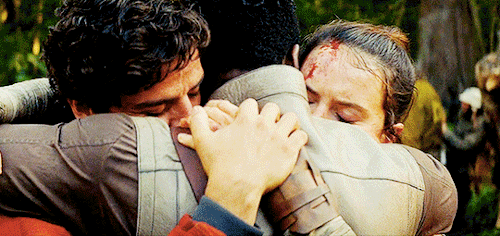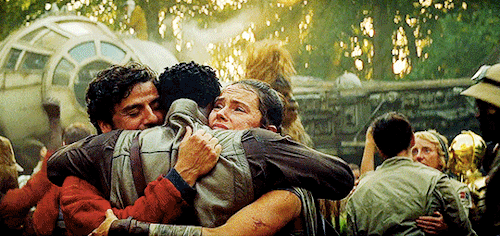Creating Fictional Holidays
Creating Fictional Holidays
Every culture and society has holidays! They are often one of the most enjoyable parts of societies and bring people together despite all of their differences. For your story, they are a great way to take your worldbuilding to the next level and make everything feel that much more real. But, Ailey, why does my world even need holidays? Well, personally, holidays are so much fun to create. You can pretty much do whatever you want to do! And, holidays can often provide great opportunitiesfor plots and sub-plots in your story. Holidays can give your characters the opportunity to gather with family, remember the family they lost, get a great deal on a super cute maxi dress, go on a blind date, or go to an awesome costume party. We, as people, need holidays, and so do your characters! So here are some tips on creating holidays for your world.
Basic Questions to Ask Yourself
What are the rituals/traditions of your holiday?
How long is the holiday (just a day, or a week, or a month)?
If the holiday is longer than a day, does it build up? Is there a most important day, and how does that look?
How does religion influence how your holiday is celebrated?
What food is traditionally served?
How do people decorate to symbolize the holiday?
Are there gifts exchanged?
Do people traditionally play games?
Getting Inspiration
The best place to get inspiration for the holidays in your world is by looking at the world around you. Maybe your family has a super cool and quirky tradition that you always wished was a holiday, tweak it a little to fit the circumstances of your world, and boom now it is. Those traditions are important to you for a reason, and often times, family traditions can eventually morph into a national holiday. Outside of that, I would look at the holidays of both modern and national holidays. Ancient Rome and Ancient Greek have plenty of holidays for you to get inspiration from, and there are so many cultures out there that have incredible traditions that you can most certainly turn into holidays! Almost every holiday is rooted in one of five things which we’ll get to next religion, a season, war, labor, and the government. Make sure that applies to your own world as well.
Types of Holidays
Religious Holidays: Your world probably has a primary religion or primary religions. Every religion has holidays that they celebrate to celebrate their god or gods and show their devotion to them. For religious holidays, sacrifice and atonement often play a huge role. Lots of religious holidays include fasting in some part of them. Maybe, there’s a holy person who founded the religion or did something super important and all the people love them. Well then they probably have a holiday or a feast of some kind in their honor. For example, in Catholicism, Saints have Feast Days! I don’t think anyone celebrates every Saint’s Feast Day because that would be like every day of the year. Some people, especially those who live in the Saint’s home town or an area which they are the patron of, have a parade or small festival in their honor on the Feast Day. On the Feast Day of my patron Saint, St. Francis de Sales, I normally will pray a novena which is a prayer you say for nine consecutive days timed so that it ends on his Feast Day, light a candle, say another prayer specific to him on the feast day and maybe bake myself a batch of cookies.
Seasonal Holidays: Seasons are so important to our world, and lots of cultures celebrate them. Lot of important events rotate around the seasons: harvest, planting, fertility, hunting, hibernation. They mark our journey in life, year after year, and allow us to reflect on all of life’s changes. How your people celebrate seasonality is up to you. You could fashion it after holidays like the Summer and Winter Solstice or the Autumn Equinox. A holiday celebrating summer in my world takes some inspiration from May Day celebrations in England. The holiday could literally be as simple as a festival that celebrates the season’s arrival which could be really interesting if your world has different seasons than ours. Or the holidays could be more complex, tying in cultural values with the seasons. I, personally, would love to see a world with different seasons for a world that has more than four seasons because I think that could bring in some really cool holidays and festivals
War/Government Holidays: There was most likely a war or a series of wars in the history of your world. People love freedom. It’s a core value for so many people and so many countries. Therefore, most countries like to have a holiday celebrating the day they won their freedom. Almost every country has some kind of Independence Day celebration. If your country has never had to gain their independence, they’ve probably still fought and won a war before. They may celebrate their victory and take the time to remember those who died during the war like many European countries on Victory in Europe Day to celebrate the End of World War 2. Then you have your government holidays like Presidents Day in the US which isn’t really celebrated, but I do get a day off of school, so that’s always nice. Maybe the ruler of your country has decreed that their birthday is a national holiday in honor of them. Or going along with holiday’s celebrating independence, maybe the country celebrates the birthday of their founder every year in a national holiday!
Labor Holidays: And lastly, we have our labor holidays, which are some of the best holidays in my opinion. Everyone needs a break at times. Labor holidays acknowledge that, and they give you the day off with absolutely zero strings attached. No church, no war to hold remembrance for, just a party with your friends, no school and no work. These holidays are not the best but also probably some of the most important. If the people in your world work five days a week (assuming weekends and a similar calendar schedule) without any long breaks, they are going to get burnt out. Burnt out people are easily irritable, and easily irritable people lead revolutions. Giving your people a holiday where they don’t have to think about anything else other than themselves is a great way to keep the people appeased!
More Posts from Lune-versatile and Others
Show, don’t tell
"Show, don’t tell" means letting readers experience a story through actions, senses, and dialogue instead of outright explaining things. Here are some practical tips to achieve that:
1. Use Sensory Details
Tell: "The room was cold."
Show: "Her breath puffed in faint clouds, and she shivered as frost clung to the edges of the window."
Tell: "He was scared."
Show: "His hands trembled, and his heart thudded so loudly he was sure they could hear it too."
2. Focus on Actions
Tell: "She was angry."
Show: "She slammed the mug onto the counter, coffee sloshing over the rim as her jaw clenched."
Tell: "He was exhausted."
Show: "He stumbled through the door, collapsing onto the couch without even bothering to remove his shoes."
3. Use Dialogue
What characters say and how they say it can reveal their emotions, intentions, or traits.
Tell: "She was worried about the storm."
Show: "Do you think it'll reach us?" she asked, her voice tight, her fingers twisting the hem of her shirt.
4. Show Internal Conflict Through Thoughts or Reactions
Tell: "He was jealous of his friend."
Show: "As his friend held up the trophy, he forced a smile, swallowing the bitter lump rising in his throat."
5. Describe the Environment to Reflect Mood
Use the setting to mirror or hint at emotions or themes.
Tell: "The town was eerie."
Show: "Empty streets stretched into the mist, and the only sound was the faint creak of a weathered sign swinging in the wind."
6. Let Readers Infer Through Context
Give enough clues for the reader to piece things together without spelling it out.
Tell: "The man was a thief."
Show: "He moved through the crowd, fingers brushing pockets, his hand darting away with a glint of gold."
7. Use Subtext in Interactions
What’s left unsaid can reveal as much as what’s spoken.
Tell: "They were uncomfortable around each other."
Show: "He avoided her eyes, pretending to study the painting on the wall. She smoothed her dress for the third time, her fingers fumbling with the hem."
8. Compare to Relatable Experiences
Use metaphors, similes, or comparisons to make an emotion or situation vivid.
Tell: "The mountain was huge."
Show: "The mountain loomed above them, its peak disappearing into the clouds, as if it pierced the heavens."
Practice Example:
Tell: "The village had been destroyed by the fire."
Show: "Charred beams jutted from the rubble like broken ribs, the acrid smell of ash lingering in the air. A child's shoe lay half-buried in the soot, its leather curled from the heat."
A Complete Beginner’s Guide to Moodboards
Please note that this is a guide for complete beginners who have no idea how to get started on making moodboards. Only the very basics will be covered here.
Have you ever wanted to make a moodboard but didn’t know where to start? You have ideas but you have never edited a picture before? Can’t afford photoshop and don’t know how to use it? Look here, this guide is for you!
This guide includes: Free photoshop alternatives, where to find images, and basic tips and tricks to make your moodboard. Click the Read More below :)
Afficher davantage
Some tips for using a few words to describe voices:
1. Tone Words: Use tone words to convey the emotional quality of a voice. For example, you can describe a voice as "melodic," "soothing," "sharp," "gentle," or "commanding" to give readers a sense of the tone.
2. Pitch and Range: Mention the pitch and range of the voice. Is it "deep," "high-pitched," "raspy," or "full-bodied"? This can provide insight into the character's age, gender, or emotional state.
3. Accent and Diction: Describe the character's accent or diction briefly to give a sense of their background or cultural influences. For instance, "British-accented," "Southern drawl," or "formal."
4. Volume: Mention the volume of the voice, whether it's "whispering," "booming," "murmuring," or "hushed."
5. Quality: Use terms like "velvet," "silken," "gravelly," "honeyed," or "crisp" to convey the texture or quality of the voice.
6. Rate of Speech: Describe how fast or slow the character speaks, using words like "rapid," "slurred," "measured," or "rambling."
7. Mood or Emotion: Indicate the mood or emotion carried by the voice. For example, a "quivering" voice may convey fear or anxiety, while a "warm" voice may express comfort and reassurance.
8. Resonance: Describe the resonance of the voice, such as "echoing," "nasal," "booming," or "tinny."
9. Timbre: Mention the timbre of the voice, using words like "rich," "thin," "clear," or "smoky."
10. Cadence: Highlight the rhythm or cadence of speech with descriptors like "staccato," "lilting," "rhythmic," or "halting."
11. Intonation: Convey the character's intonation by saying their voice is "sarcastic," "apologetic," "confident," or "questioning."
12. Vocal Characteristics: If applicable, mention unique vocal characteristics, like a "lisp," "stutter," "drawl," or "accented 'r'."


This Halloween, you better bring your reading glasses, because it's time to whack out word crimes that bring out the absolute worst (affectionate) in the great universe of Romance Club.
To help out, we've compiled an eclectic spread of writing resources for your convenience - and please, if you have additional suggestions for your fellow writer, let us know in the comments!
Spooky Writing Prompts - by @daydreaming-effy
Halloween Fluff Prompts - by @asparklerwhowrites
Halloween-themed Dialogue Prompts - by @palettes-and-prompts
30 Whumpy Dialogue Prompts - by @wildfaewhump
Lists of Prompts I and II grouped by mood - by @linwritesif
Monster x Monster Hunter Prompts - by @deity-prompts
A Sense of Horror (inspiration) - by @whump-queen
Monstrous May 2021 Write-Up (inspiration - please note: occasionally suggestive) - by Johannes T. Evans
9 Tricks For Writing Suspense Fiction (inspiration) - by Simon Wood on Writer's Digest
What Even Is Suspense (inspiration - not a promotion at all, just a few good points if you're unsure how to ramp up the scaries) - through Masterclass.com
I hate to say this, and like, rain on everyone’s parade, but after scrolling past three posts about it on a writing tag …
If you are looking up synonyms to exchange words out in your story with the purpose of sounding smarter, more sophisticated, or complicated to your reader, you are probably abusing the thesaurus.
Now, if you *want* to do this, I mean, you can write whatever or however you want! But I just want you to know that this is frowned upon if you are trying to write at a professional level.
I have an old article on this somewhere …


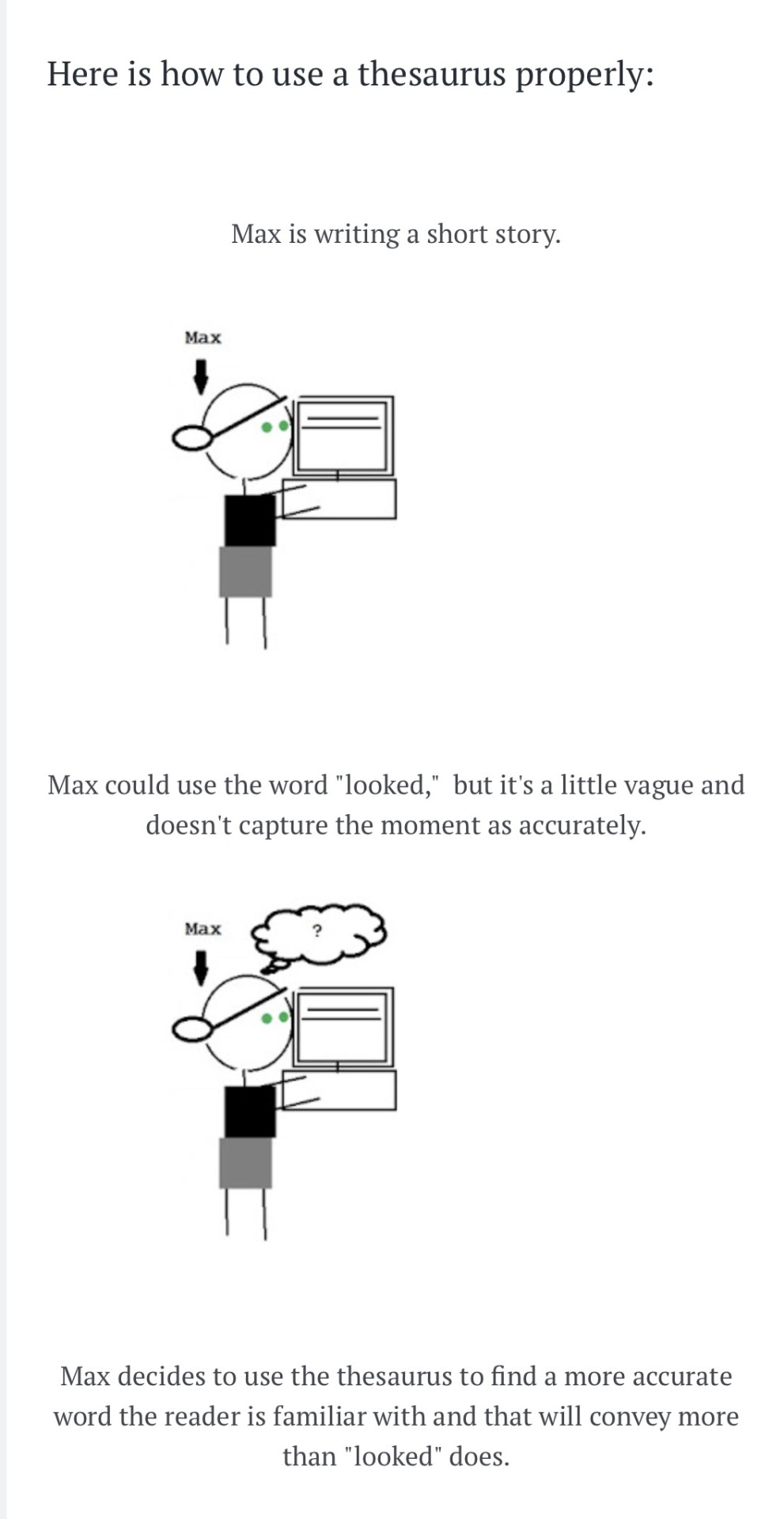
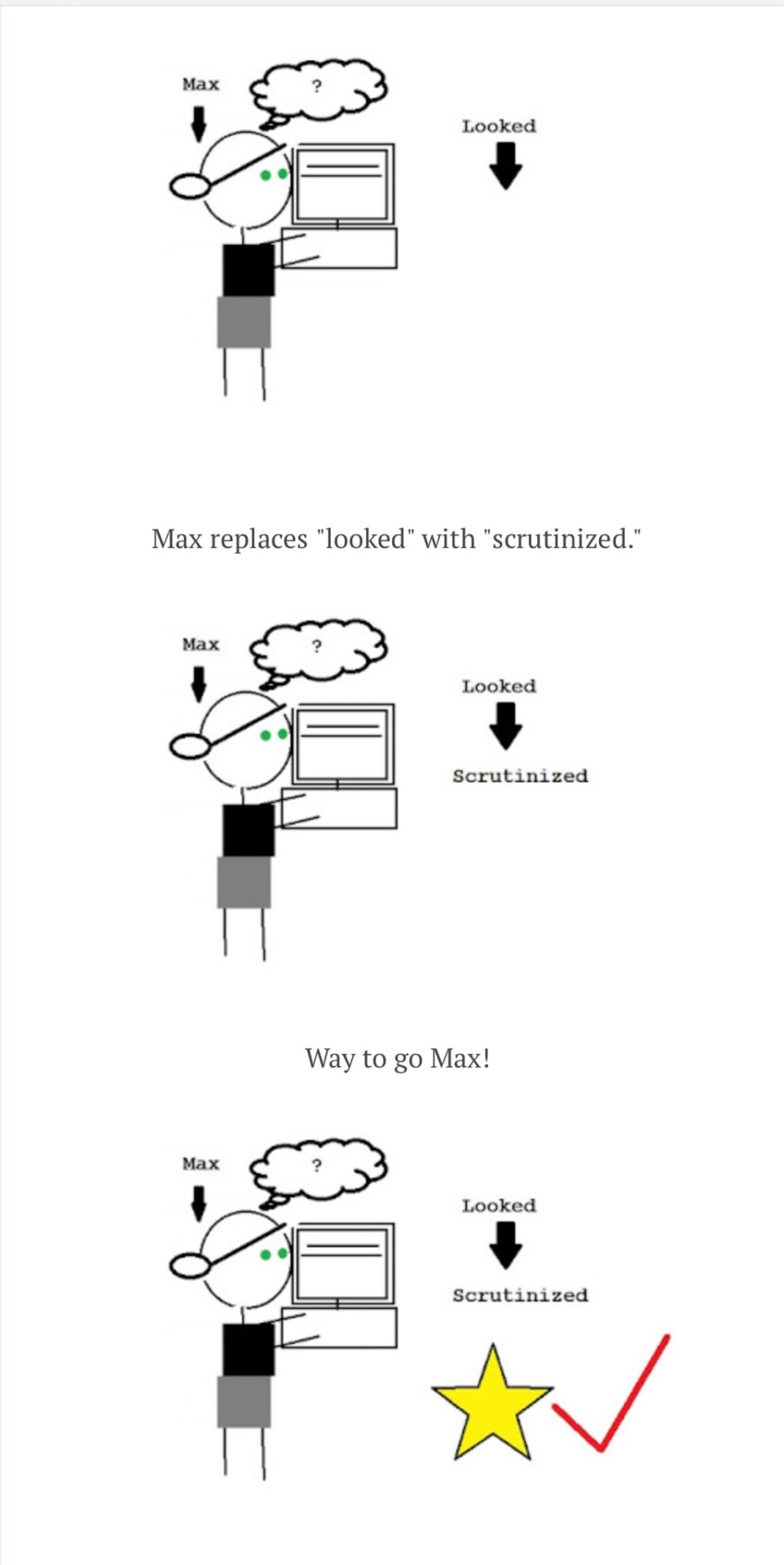
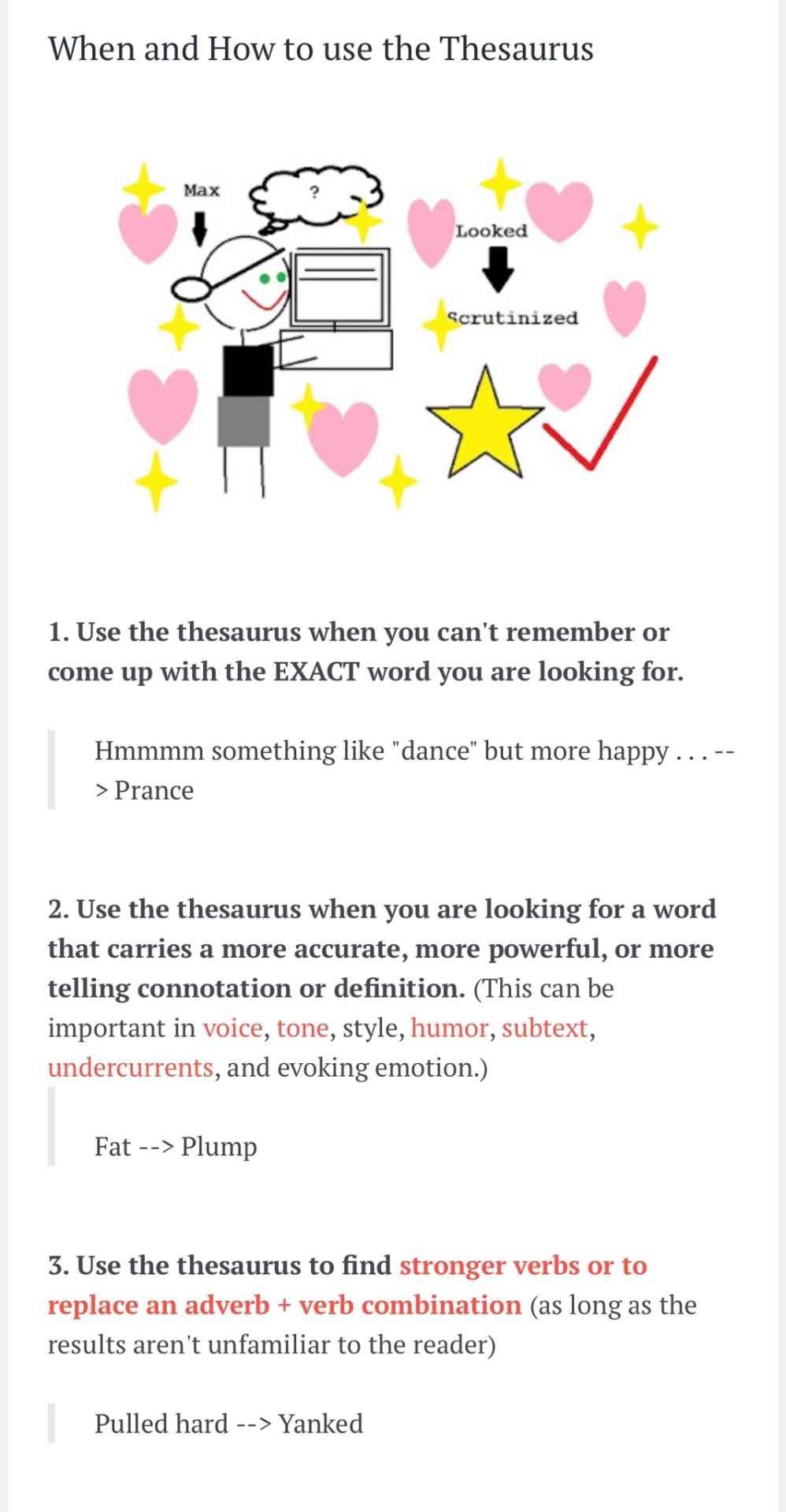

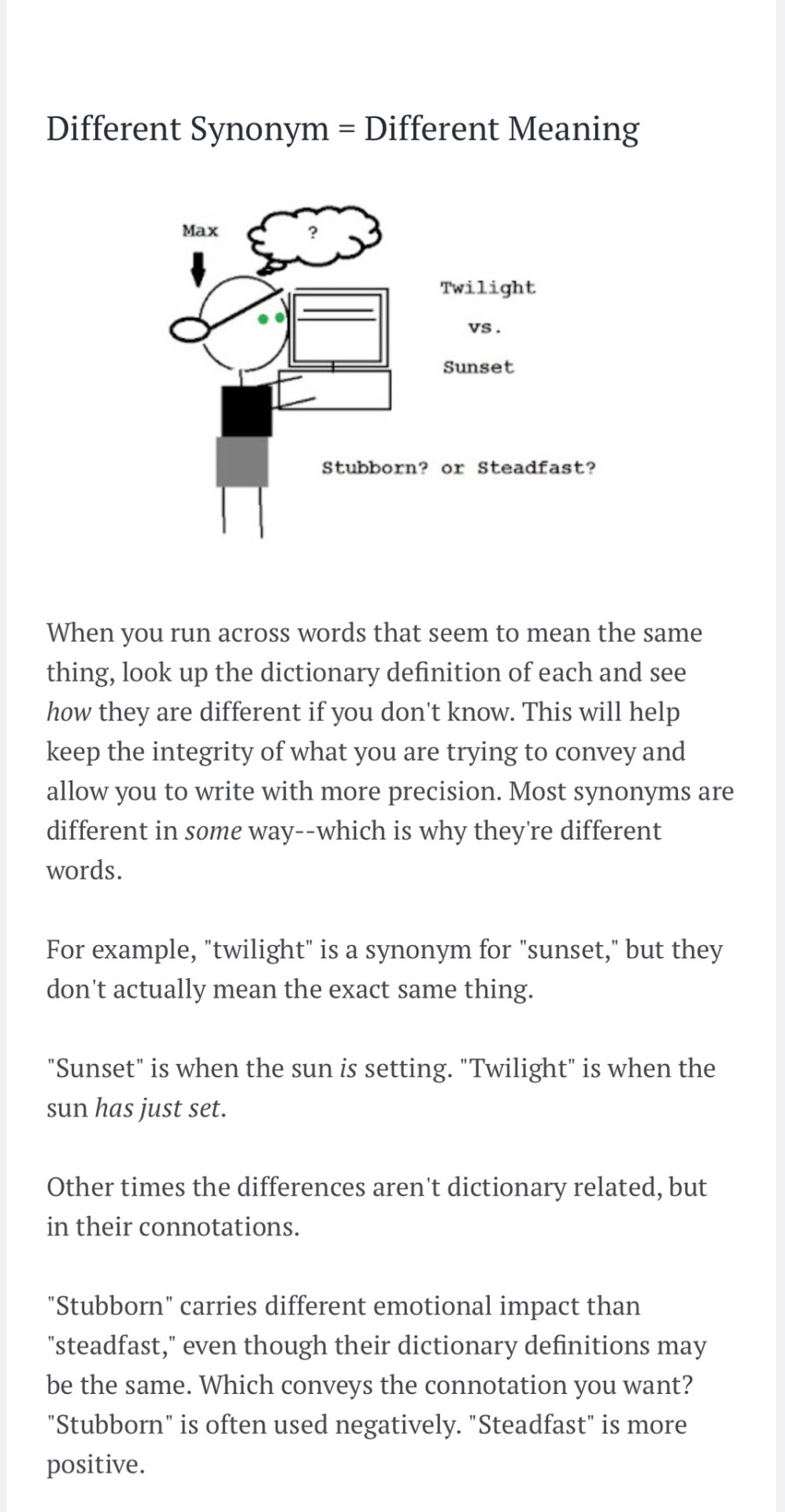
If you want to look at the original article…
https://www.septembercfawkes.com/2018/08/how-to-use-thesaurus-properly.html

The right FREE tools to write a book
hello hello, it's me!
today I was thinking of how much you loved my masterlist featuring some free tools for writers, and I thought I would do something like that again but, this time, featuring just one or two tools per step while getting the best of "the writer's workbook" (which is also free).
before going any further, for those who don't know, "the writer's workbook" is, as the name says, a workbook for writers, with over 90 pages. it has lots of sheets divided into categories, to help you build the skeleton of your novel. (know more about it here).
however, we can get the most out of it using other complementary tools to ease this process.
Brainstorming
Reedsy generator - it's one of my favorites, and it can be quite useful when you're stuck and want to get an idea. you're free to make changes to it so that it is as unique as possible.
Mindmap
Lucidspark - although it has a premium version, I find it so helpful when it comes to making a mindmap. I've used it multiple times before, including for college assignments, and it's one of the best I've found so far.
Mindmup - I'm sharing this one here as an alternative to lucidspark, since this one doesn't require to create an account, and you have access to unlimited maps. however, in my opinion, it is not as good or intuitive as lucidspark is.
Come up with names
Behind the name - it's a classic, but one of my favorites. you can search every name you could ever imagine, and get its meaning, history, variations, etc. it still has some tools you can use such as a name generator, anagrams, and much more.
Make a profile
Fake person generator - although it was not created for authors, you might find it useful since it gives lots of details and you can be interested in some fields.
Character generator - this one was made for writers, and is simple and easy to use.
Family tree
Family echo - it's so simple yet so helpful.
Maps
Inkarnate - it has a paid version, but you can use it for free and create a great map.
Politics
Filteries - this is sooo complete and accurate!
hope this was helpful! have a nice day <3
Tips for Build up the tension
Introduce a mysterious character or event that captures the reader's interest from the outset, like a protagonist receiving a cryptic message or stumbling upon a hidden artifact.
End a chapter with a sudden revelation or a character in peril, leaving readers eager to find out what happens next. For instance, a chapter ending with the sound of a gunshot but without revealing who fired it.
Drop hints about future events or conflicts throughout the story, such as a character experiencing recurring nightmares that seem to foretell danger.
Introduce friction between characters with opposing goals or values, leading to heated arguments or tense standoffs.
Use a narrator with a skewed perspective or hidden agenda, causing readers to question the accuracy of the events described.
Describe the setting in a way that evokes a sense of foreboding or unease, like a dark, abandoned mansion shrouded in mist.
Gradually unveil the protagonist's backstory or a central mystery piece by piece, keeping readers guessing and eager for more revelations.
Subvert genre conventions or tropes to keep readers guessing, such as portraying a seemingly trustworthy character as the ultimate villain.
Incorporate unexpected plot twists or betrayals that challenge the protagonist's assumptions and force them to adapt.
WEBSITES FOR WRITERS {masterpost}
E.A. Deverell - FREE worksheets (characters, world building, narrator, etc.) and paid courses;
Hiveword - Helps to research any topic to write about (has other resources, too);
BetaBooks - Share your draft with your beta reader (can be more than one), and see where they stopped reading, their comments, etc.;
Charlotte Dillon - Research links;
Writing realistic injuries - The title is pretty self-explanatory: while writing about an injury, take a look at this useful website;
One Stop for Writers - You guys... this website has literally everything we need: a) Description thesaurus collection, b) Character builder, c) Story maps, d) Scene maps & timelines, e) World building surveys, f) Worksheets, f) Tutorials, and much more! Although it has a paid plan ($90/year | $50/6 months | $9/month), you can still get a 2-week FREE trial;
One Stop for Writers Roadmap - It has many tips for you, divided into three different topics: a) How to plan a story, b) How to write a story, c) How to revise a story. The best thing about this? It's FREE!
Story Structure Database - The Story Structure Database is an archive of books and movies, recording all their major plot points;
National Centre for Writing - FREE worksheets and writing courses. Has also paid courses;
Penguin Random House - Has some writing contests and great opportunities;
Crime Reads - Get inspired before writing a crime scene;
The Creative Academy for Writers - "Writers helping writers along every step of the path to publication." It's FREE and has ZOOM writing rooms;
Reedsy - "A trusted place to learn how to successfully publish your book" It has many tips, and tools (generators), contests, prompts lists, etc. FREE;
QueryTracker - Find agents for your books (personally, I've never used this before, but I thought I should feature it here);
Pacemaker - Track your goals (example: Write 50K words - then, everytime you write, you track the number of the words, and it will make a graphic for you with your progress). It's FREE but has a paid plan;
Save the Cat! - The blog of the most known storytelling method. You can find posts, sheets, a software (student discount - 70%), and other things;
I hope this is helpful for you!
(Also, check my blog if you want to!)
-
 eternalparadisearchive reblogged this · 4 days ago
eternalparadisearchive reblogged this · 4 days ago -
 antihell liked this · 5 days ago
antihell liked this · 5 days ago -
 yoshias reblogged this · 1 year ago
yoshias reblogged this · 1 year ago -
 yoshias liked this · 1 year ago
yoshias liked this · 1 year ago -
 heckcareoxytwit reblogged this · 1 year ago
heckcareoxytwit reblogged this · 1 year ago -
 arthumbojumbo reblogged this · 1 year ago
arthumbojumbo reblogged this · 1 year ago -
 electric-safflina liked this · 2 years ago
electric-safflina liked this · 2 years ago -
 unwelcomeaura reblogged this · 2 years ago
unwelcomeaura reblogged this · 2 years ago -
 fabian-mint-archive reblogged this · 2 years ago
fabian-mint-archive reblogged this · 2 years ago -
 jasshands liked this · 2 years ago
jasshands liked this · 2 years ago -
 brooklynsbridge reblogged this · 2 years ago
brooklynsbridge reblogged this · 2 years ago -
 degeneratekilljoy1 reblogged this · 2 years ago
degeneratekilljoy1 reblogged this · 2 years ago -
 degeneratekilljoy1 liked this · 2 years ago
degeneratekilljoy1 liked this · 2 years ago -
 whisperwhiskaway reblogged this · 2 years ago
whisperwhiskaway reblogged this · 2 years ago -
 s2-shewolf-s2 liked this · 2 years ago
s2-shewolf-s2 liked this · 2 years ago -
 valeria-sage liked this · 2 years ago
valeria-sage liked this · 2 years ago -
 creativelym3 liked this · 2 years ago
creativelym3 liked this · 2 years ago -
 darkscorpiox liked this · 2 years ago
darkscorpiox liked this · 2 years ago -
 yenoodlethings liked this · 2 years ago
yenoodlethings liked this · 2 years ago -
 chaosinthesixth liked this · 2 years ago
chaosinthesixth liked this · 2 years ago -
 jubo-love liked this · 2 years ago
jubo-love liked this · 2 years ago -
 frankly-dear liked this · 2 years ago
frankly-dear liked this · 2 years ago -
 internet-or-sleep reblogged this · 2 years ago
internet-or-sleep reblogged this · 2 years ago -
 internet-or-sleep liked this · 2 years ago
internet-or-sleep liked this · 2 years ago -
 jackdawjack liked this · 3 years ago
jackdawjack liked this · 3 years ago -
 the-seven-wings reblogged this · 3 years ago
the-seven-wings reblogged this · 3 years ago -
 deer-in-headlights-stare reblogged this · 3 years ago
deer-in-headlights-stare reblogged this · 3 years ago -
 hexord reblogged this · 3 years ago
hexord reblogged this · 3 years ago -
 character-and-refrences reblogged this · 3 years ago
character-and-refrences reblogged this · 3 years ago -
 phrog-crime liked this · 3 years ago
phrog-crime liked this · 3 years ago -
 fxtedmxses liked this · 3 years ago
fxtedmxses liked this · 3 years ago -
 linalinalu reblogged this · 3 years ago
linalinalu reblogged this · 3 years ago -
 algumaideia liked this · 3 years ago
algumaideia liked this · 3 years ago -
 blood-ology liked this · 3 years ago
blood-ology liked this · 3 years ago -
 shikse reblogged this · 3 years ago
shikse reblogged this · 3 years ago -
 shikse liked this · 3 years ago
shikse liked this · 3 years ago -
 knightofnightmoo liked this · 3 years ago
knightofnightmoo liked this · 3 years ago -
 godsavetheneptun liked this · 3 years ago
godsavetheneptun liked this · 3 years ago -
 revisink liked this · 3 years ago
revisink liked this · 3 years ago -
 merleyfox liked this · 3 years ago
merleyfox liked this · 3 years ago -
 bug-writes reblogged this · 3 years ago
bug-writes reblogged this · 3 years ago -
 legend606 reblogged this · 3 years ago
legend606 reblogged this · 3 years ago -
 humbuggery101 liked this · 3 years ago
humbuggery101 liked this · 3 years ago -
 redd004 reblogged this · 3 years ago
redd004 reblogged this · 3 years ago




